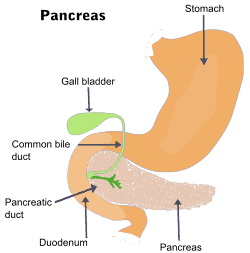Researchers at UCLA’s Jonsson Comprehensive Cancer Center have developed a new technique for fighting deadly and hard-to-treat pancreatic cancer that uses two different types of nanoparticles, the first type clearing a path into tumor cells for the second, which delivers chemotherapy drugs.
The research team, led by Dr. Andre Nel, a UCLA professor of nanomedicine and a member of the California NanoSystems Institute at UCLA, and Dr. Huan Meng, a UCLA adjunct assistant professor of nanomedicine, has shown that this new drug-delivery technique is effective in treating pancreatic cancer in a mouse model.
The results of the study are published online in the journal ACS Nano and will be featured in the November 2013 print issue.
Pancreatic ductal adenocarcinoma, or pancreatic cancer, is a deadly disease that is nearly impossible to detect until it is in the advanced stage. Treatment options are limited and have low success rates. The need for innovative and improved treatment of pancreatic cancer cannot be overstated, the researchers said, as a pancreatic cancer diagnosis has often been synonymous with a death sentence.
Pancreatic ductal adenocarcinoma tumors are made up of cancer cells that are surrounded by other structural elements called stroma. The stroma can be made of many substances, including connective tissue and pericyte cells, which block standard chemotherapy drugs in tumor blood vessels from efficiently reaching the cancer cells, reducing the effectiveness of treatment.
The dual-wave nanotherapy method employed by Nel and Meng uses two different kinds of nanoparticles injected intravenously in a rapid succession. The first wave of nanoparticles carries a substance that removes the pericytes’ vascular gates, opening up access to the pancreatic cancer cells; the second wave carries the chemotherapy drug that kills the cancer cells.
Nel and Meng, along with colleagues Dr. Jeffrey Zink, a UCLA professor of chemistry and biochemistry, and Dr. Jeffrey Brinker, a University of New Mexico professor of chemical and nuclear engineering, sought to place chemotherapy drugs into nanoparticles that could more directly target pancreatic cancer cells, but they first needed to find a way to get those nanoparticles through the sites of vascular obstruction caused by pericytes, which restrict access to the cancer cells.
Through experimentation, they discovered they could interfere with a cellular signaling pathway — the communication mechanism between cells — that governs the pericytes’ attraction to the tumor blood vessels. By creating nanoparticles that effectively bind a high load of the signaling pathway inhibitor, the researchers were able to develop a first wave of nanoparticles that would separate the pericytes from the endothelial cells on the blood vessel. This would open the vascular gate for the next wave of nanoparticles, which carry the chemotherapeutic agent to the cancer cells inside the tumor.
To test this nanotherapy, the researchers used immuno-compromised mice in which they grew human pancreatic tumors called xenografts under the skin. With the two-wave method, the xenograft tumors had a significantly higher rate of shrinkage than tumors exposed only to chemotherapy given as a free drug or carried in nanoparticles without first-wave treatment.
“This two-wave nanotherapy is an existing example of how we seek to improve the delivery of chemotherapy drugs to their intended targets using nanotechnology to provide an engineered approach,” said Nel, chief of UCLA’s division of nanomedicine. “It shows how the physical and chemical principles of nanotechnology can be integrated with the biological sciences to help cancer patients by increasing the effectiveness of chemotherapy while also reducing side effects and toxicity. This two-wave treatment approach can also address biological impediments in nanotherapies for other types of cancer.”
The research was funded by the U.S. Public Health Service and the National Cancer Institute.
UCLA’s Jonsson Comprehensive Cancer Center has more than 240 researchers and clinicians engaged in disease research, prevention, detection, control, treatment and education. One of the nation’s largest comprehensive cancer centers, the Jonsson center is dedicated to promoting research and translating basic science into leading-edge clinical studies. In July 2013, the Jonsson Cancer Center was named among the top 12 cancer centers nationwide by U.S. News & World Report, a ranking it has held for 14 consecutive year


